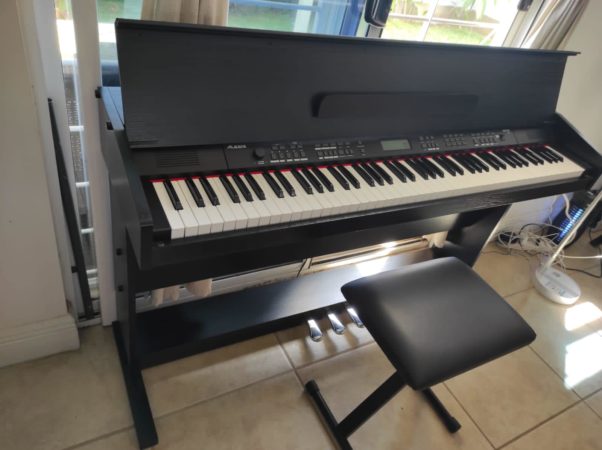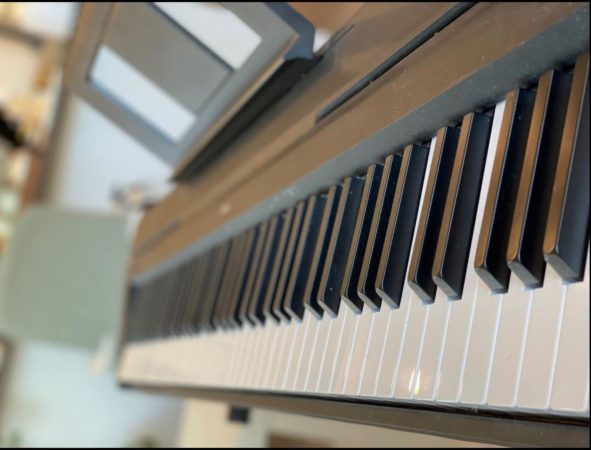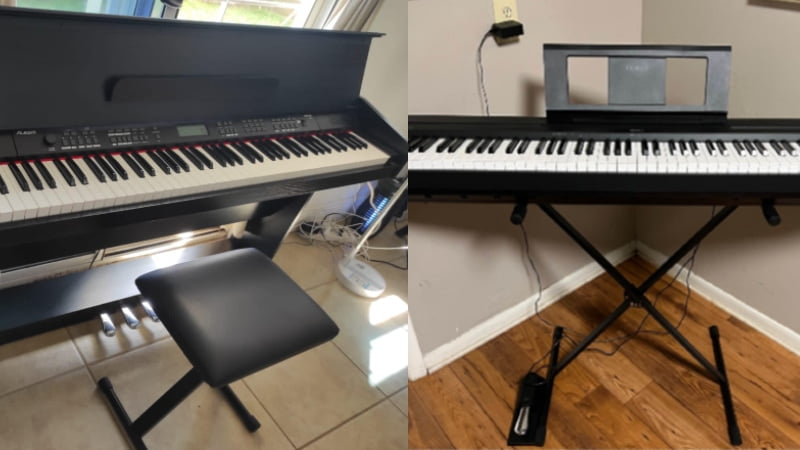The Yamaha P71 is highly lauded in musician’s circles. It is a quality piano with some great features available at a bargain of a price. But with the Alesis Virtue slowly gaining popularity amongst beginners, many people are asking, who wins in an Alesis Virtue vs Yamaha P71 comparison?
To save you the trouble, I did the research and tested out these options myself. And by the end, I found that the Alesis Virtue was the winner, but only by slim margins.
There are clear flaws with the Alesis Virtue, particularly when it comes to feel. But the Yamaha P71 has its own flaws as well and after a careful comparison, I found that the Alesis Virtue offered more versatility and functionality, especially for beginners.
So, if you’re looking for your first piano to get your started, either of these options will serve you well. But if you’re looking for a little extra, the Alesis Virtue offers a bit more than the Yamaha P71.
Alesis Virtue vs Yamaha P71: Comparison Chart




Last update on 2025-07-11 / Affiliate links / Images from Amazon Product Advertising API
Alesis Virtue vs Yamaha P71: A Head to Head Comparison
To determine the clear-cut winner between the two, I decided my best option was to compare each of the features and keep score. And after comparing the tone, feel, and extra features of these two pianos, the final score was 2-1, in favor of the Alesis Virtue. Since it has a wider sound library and more varied piano features, the Alesis Virtue narrowly edged out a win over the Yamaha P71.
Tone
The winner: Alesis Virtue
When choosing a piano, tone should be a top consideration. After all, you always want a digital piano that can accurately emulate the sound of a real acoustic piano. And while the Yamaha P71 has a slightly more sophisticated tone engine, it was hard to beat out the versatility of the Alesis Virtue’s sound library, which has over 360 different voices!

+Tone Generation
The Alesis Virtue uses the standard sampling method for its tones. On the flip side, the Yamaha P71 uses the highly-lauded AWM Sampling Method of Yamaha. And while AWM might sound fancy, it’s just a complicated term for the same sampling method used by the Alesis Virtue.
While they have different names, the tones of both of these pianos are generated in relatively the same way. Each of the pianos is loaded with a specific set of different samples or recordings of different instruments. And whenever a musician presses down on the key, one of these samples gets triggered, resulting in the tone coming out of the speakers.
This is by far the simplest method for generating tones, and it’s a big reason that both these pianos are relatively affordable. However, while it is a simple method, there are many ways to get top-quality sounds through sampling.
The secret is simply to load the piano with high-quality samples, which you can definitely hear on either of these instruments. However, I should note that the Yamaha P71 has slightly more high-quality samples than the Alesis Virtue.
With that said, the difference in quality was not enough for me to declare the P71 the winner, especially after considering the sound library of the Alesis Virtue.
+Sound Library
The main reason that I found the Alesis Virtue as the winner in terms of tone is the sound library. Sadly, the Yamaha P71 only comes with 10 different piano tones. While Yamaha chose to focus on quality over quantity and all the voices on the P71 sound great, they are undeniably limiting, regardless of skill level.
While some piano teachers prefer that their students only have a few voices so that they don’t get distracted, it’s always better to have versatility in your instruments. And the Alesis Virtue brings a whole lot of versatility with it.
On the Alesis Virtue, you can experiment with up to 360 different tones! This includes standard acoustic and electric piano voices, organ, synth, and bass voices, as well as a couple of more unique options like drums and SFX!
Granted, not all of these tones are high-quality. In fact, there may be a handful of sound packs on the Alesis Virtue that sound so digital they are almost unusable. However, there are still tons of voices on the Alesis Virtue that offer tons of usability for a variety of genres and playing styles.
Feel & Playabillity
The winner: Yamaha P71

The main complaint I had with the Alesis Virtue is the feel. Since this is a very budget-friendly option, it was no surprise that I had my own set of qualms with how it felt to play the Alesis Virtue, but it was easily forgivable because of the price.
While the Alesis Virtue has a full, 88-key keyboard, none of the keys are weighted. So, you won’t get any resistance when playing this instrument. However, children and beginners with light hands might actually enjoy this more since it’s easier to press down on the keys.
With that said, the Yamaha P71 comes with fully-weighted keys, which automatically made it the winner between the two. While it might be hard to play with fully-weighted keys as a beginner, it’s a learning curve that students have to get over.
Fully-weighted keys offer a much more realistic experience. So, with the Yamaha P71, it’s much easier to get accustomed to playing on an acoustic piano since it offers similar resistance.
And because of the fully-weighted keys, the Yamaha P71 easily won out when it came to feel and playability.
Piano Features
The winner: Alesis Virtue
Yamaha is typically known for offering a wide array of piano features on their digital instruments. But since the Yamaha P71 is considered the entry-level Amazon exclusive, it doesn’t offer as much functionality or versatility as other models on the market. The Alesis Virtue, on the other hand, does, which is why it’s such a great pick for beginners and novice players alike.
+Playing Modes
When it came down to playing modes, these two pianos only shared one: dual. This is also referred to as layering mode and it allows players to load two voices at the same time. So, instead of triggering one sample per key, you trigger multiple.
The result is a unique blend of two voices that you won’t be able to find as a preset. However, while both pianos have the feature, keep in mind that the Alesis Virtue has more voices, so you have more room for experimentation.
On top of dual mode, the Alesis Virtue features split and recording mode. With split mode, you can divide the piano into two distinct zones, each with a different voice. This gives the illusion of playing multiple instruments at a time and you can apply it in a variety of different playing styles.
With recording mode, you can record yourself playing and listen back. From there, you can figure out areas that need improvement as well as appreciate areas of the piece where you played well. This is a great feature for both students and novices as being able to listen to your playing is a very important part of the learning process.
+Polyphony
Another area where I found that the Alesis Virtue won over the Yamaha P71 is in terms of polyphony. With the Yamaha P71, you only get a maximum polyphony of 64 notes. While this is more than enough for most beginner pieces, it’s also undeniably limiting.
While it may not seem possible to play 64 notes at a time in a single piece, it actually is. If you use the sustain pedal or layering mode, you play multiple samples whenever you press a key. So, this can reduce the number of notes you can play at the same time, which can get in the way of some pieces of music.
On the flip side, the Alesis Virtue boasts 128-note maximum polyphony. In the world of digital pianos, this is largely considered the standard as it can cover most playing styles with dense chords, even with the sustain pedal on.
So, while the Yamaha P71 offers slightly higher quality tones and a better feel, it simply couldn’t match the versatility of the Alesis Virtue, which I found to be the winner in this comparison.
Alesis Virtue vs Yamaha P71: The Similarities
Despite one being a console digital piano and the other being a portable option, these two share a fair amount of similarities. For starters, they both have 88-key keyboards. In this price range, there are a bunch of models out there that only have 61 and 49 keys, so the fact they have full keyboards is a huge plus.
On top of that, both models come with similar effects. The Yamaha P71 and Alesis Virtue both come with reverb, which is arguably the most important effect out there for most pianists. While the Alesis Virtue also features a chorus effect, it doesn’t make that big of a difference in the long run.
However, from there, the similarities are very few and far between. These are two different pianos that were designed for beginners. The Yamaha P71 offers a portable option with a few great tones while the Alesis Virtue offers a budget-friendly console piano with a very wide array of features and voices.
Quick Rundown of the Alesis Virtue
- Everything You Need - 88 full-sized keys with velocity sensitivity and adjustable touch response, 3 pedals (sustain, soft, sostenuto), easy-to-assemble wooden stand with music rest and an adjustable piano bench.
- Superior Sound - 360 built-in premium voices with the ability to split or layer 2 voices simultaneously; 30-watt stereo speakers (15W X 2) and 128-note max polyphony for realistic sound and playability
- Compose, Create, Record - One-touch song mode with 160 built-in accompaniment styles; 80 demo songs; Record mode enables you to record and then listen back to your performance
- Powerful Educational Features - Lesson mode divides the keyboard into two sections with the same pitch and voice; Built-in metronome with a 30-280 BPM range; Backlit LCD screen clearly shows chord names and notation
- Learn Piano Today - Includes Skoove 3-month premium subscription for expert interactive online piano lessons
Last update on 2025-07-11 / Affiliate links / Images from Amazon Product Advertising API
Quick Rundown of the Yamaha P71
- Acoustic Piano Feel - Touch-sensitive keys allow for true expression and dynamic performance. The weighted action replicates the acoustic piano experience
- Elevated Sound - Choose from 10 unique Voices, including the richness and resonance of a Yamaha grand piano, with full dynamic sound and deep bass
- Effortless Control - Simple one-button operation and streamlined functionality designed to keep you focused on your music
- Layered Sound - Dual Mode lets you blend two Voices, like piano and strings, creating a rich, layered sound for an inspiring new playing experience
- Included sustain pedal allows for subtle variations and greater expression in your performances
Last update on 2025-07-11 / Affiliate links / Images from Amazon Product Advertising API
Product Videos
Related Articles to Alesis Virtue
Related Articles to Yamaha P71
- Yamaha P71 vs P95: Which Is The Better Digital Piano?
- Yamaha P71 vs Korg B2 Comparison: Battle Of the Two Top Beginner Pianos On the Market
- Yamaha P71 vs Casio CDP-S150: Which Is the Best Beginner Piano On the Market?
- Yamaha P71 vs DGX-660: Can the Amazon Exclusive Beat Out the Premium Model?
- Yamaha P71 vs Donner DEP-20: Which Is the Best Beginner Piano?
- Yamaha P71 vs Casio PX-160 Comparison: Battle of the Two Best Digital Pianos on a Budget
- Yamaha P71 vs Alesis Recital: Why the Amazon Exclusive P71 Is the Best Option for Beginners
- Yamaha P71 vs Roland FP10 Review: A Tight-Knit Battle Where The FP10 Comes Out On Top
- Yamaha P71 vs Alesis Recital Pro: Which Digital Piano is the Best Option for Beginners?
- Yamaha P71 vs P125: Why the Yamaha P125 Is the Better Investment
- Yamaha P71 vs P45: Why the Amazon Exclusive P71 is the Better Digital Piano
Reference
- Alesis Virtue: https://www.amazon.com/dp/B01LY8OUQW
- Yamaha P71: https://www.sweetwater.com/store/detail/Virtue–alesis-virtue-88-key-digital-piano-with-wood-stand-and-bench
Lulacruza is an electronic folk duo operating at the junction of the hypermodern and the ancient. Our music weaves together hypnotic female singing, South American folk instruments and electronic processing, while channeling pulsating waves from the source of creation.
Lalucruza is also a community where you can connect with other music lovers to collaborate, exchange ideas and share knowledge. A platform for who wants to learns the basics of playing piano, guitar, drum masters’ technique, etc.. is the premise of our website.
